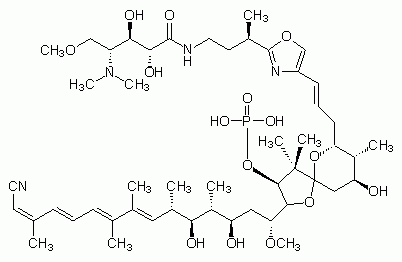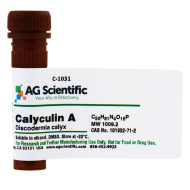Calyculin A, a marine toxin isolated from Disodermia calyx, is a structurally distinct inhibitor of PP1 (protein phosphatase 1) and protein phosphatase 2A (PP2). It has been shown that Calyculin A displays inhibitory properties towards the endogenous phosphatase of smooth muscle myosin B and induces contraction in the muscle fibers.
 Product Number: C-1031
CAS #: [101932-71-2]
Chemical Formula: C50H81N4O15P
Appearance: Oil
Molecular Weight: 1009.2
Purity: >98%
Solubility: Soluble in DMSO, Ethanol, DMF.
Storage Temp: -20°C
OVERVIEW
Calyculin A, a marine toxin isolated from Disodermia calyx, is a structurally distinct inhibitor of PP1 (protein phosphatase 1) and protein phosphatase 2A (PP2). It has been shown that Calyculin A displays inhibitory properties towards the endogenous phosphatase of smooth muscle myosin B and induces contraction in the muscle fibers. Contraction induced by Calyculin A was accompanied by an increase in the cytosolic free Ca++ concentration. Additionally it has been reported that this compound can bind to protein phosphatases in mouse skin, which serve as okadaic acid receptors. Consequentially Calyculin A induces ornithine decarboxylase in the mouse skin and is believed to promote tumor growth.
MOUSE SKIN EXPERIMENT
Product Number: C-1031
CAS #: [101932-71-2]
Chemical Formula: C50H81N4O15P
Appearance: Oil
Molecular Weight: 1009.2
Purity: >98%
Solubility: Soluble in DMSO, Ethanol, DMF.
Storage Temp: -20°C
OVERVIEW
Calyculin A, a marine toxin isolated from Disodermia calyx, is a structurally distinct inhibitor of PP1 (protein phosphatase 1) and protein phosphatase 2A (PP2). It has been shown that Calyculin A displays inhibitory properties towards the endogenous phosphatase of smooth muscle myosin B and induces contraction in the muscle fibers. Contraction induced by Calyculin A was accompanied by an increase in the cytosolic free Ca++ concentration. Additionally it has been reported that this compound can bind to protein phosphatases in mouse skin, which serve as okadaic acid receptors. Consequentially Calyculin A induces ornithine decarboxylase in the mouse skin and is believed to promote tumor growth.
MOUSE SKIN EXPERIMENT
 Calyculin A, isolated from a marine sponge, has a novel spiro ketal skeleton. Structurally unrelated to okadaic acid, calyculin A bound to the okadaic acid receptors in particulate and soluble fractions of mouse skin. The biochemical and tumor-promoting activities of calyculin A were studied with those of okadaic acid. Calyculin A inhibited the activity of protein phosphatases, which serve as the okadaic acid receptors. The effective dose of calyculin A for 50% inhibition was 0.3 nm, similar to that of okadaic acid. Like okadaic acid, calyculin A induced ornithine decarboxylase in mouse skin and hyperphosphorylation of a Mr60,000 protein in human papilloma virus type 16-transformed human keratinocytes. A two-stage carcinogenesis experiment on mouse skin, initiated by 100 µg (390 nmol) of 7,12-dimethylbenz(a)anthracene and followed by 1 µg (1.0 nmol) of calyculin A, revealed that calyculin A is an additional member of the okadaic acid class of tumor promoters. The percentages of tumor-bearing mice in the groups treated with DMBA plus calyculin A, and with DMBA followed by 1 µg (1.2 nmol) of okadaic acid were 86.7 and 80.0%, respectively, in week 30. The mechanisms of action of calyculin A and okadaic acid, in addition to dinophysistoxin-1 (35-methylokadaic acid), are discussed. Calyculin A is the first tumor promoter to be screened by the okadaic acid receptor binding test.
Related Products: Okadaic acid, Prorocentrum concavum, High Purity, Okadaic acid.Ammonium Salt, Prorocentrum concavum, Okadaic acid.Potassium Salt, Prorocentrum concavum, Okadaic Acid Sodium Salt, Prorocentrum concavum, Phosphatase Inhibitor Cocktail IV
Sources: Masami Suganuma, Hirota Fujiki, Hiroko Furuya-Suguri, Shigeru Yoshizawa, Shigeru Yasumoto, Yuko Kato,Nobuhiro Fusetani, and Takashi Sugimura
Calyculin A, isolated from a marine sponge, has a novel spiro ketal skeleton. Structurally unrelated to okadaic acid, calyculin A bound to the okadaic acid receptors in particulate and soluble fractions of mouse skin. The biochemical and tumor-promoting activities of calyculin A were studied with those of okadaic acid. Calyculin A inhibited the activity of protein phosphatases, which serve as the okadaic acid receptors. The effective dose of calyculin A for 50% inhibition was 0.3 nm, similar to that of okadaic acid. Like okadaic acid, calyculin A induced ornithine decarboxylase in mouse skin and hyperphosphorylation of a Mr60,000 protein in human papilloma virus type 16-transformed human keratinocytes. A two-stage carcinogenesis experiment on mouse skin, initiated by 100 µg (390 nmol) of 7,12-dimethylbenz(a)anthracene and followed by 1 µg (1.0 nmol) of calyculin A, revealed that calyculin A is an additional member of the okadaic acid class of tumor promoters. The percentages of tumor-bearing mice in the groups treated with DMBA plus calyculin A, and with DMBA followed by 1 µg (1.2 nmol) of okadaic acid were 86.7 and 80.0%, respectively, in week 30. The mechanisms of action of calyculin A and okadaic acid, in addition to dinophysistoxin-1 (35-methylokadaic acid), are discussed. Calyculin A is the first tumor promoter to be screened by the okadaic acid receptor binding test.
Related Products: Okadaic acid, Prorocentrum concavum, High Purity, Okadaic acid.Ammonium Salt, Prorocentrum concavum, Okadaic acid.Potassium Salt, Prorocentrum concavum, Okadaic Acid Sodium Salt, Prorocentrum concavum, Phosphatase Inhibitor Cocktail IV
Sources: Masami Suganuma, Hirota Fujiki, Hiroko Furuya-Suguri, Shigeru Yoshizawa, Shigeru Yasumoto, Yuko Kato,Nobuhiro Fusetani, and Takashi Sugimura

